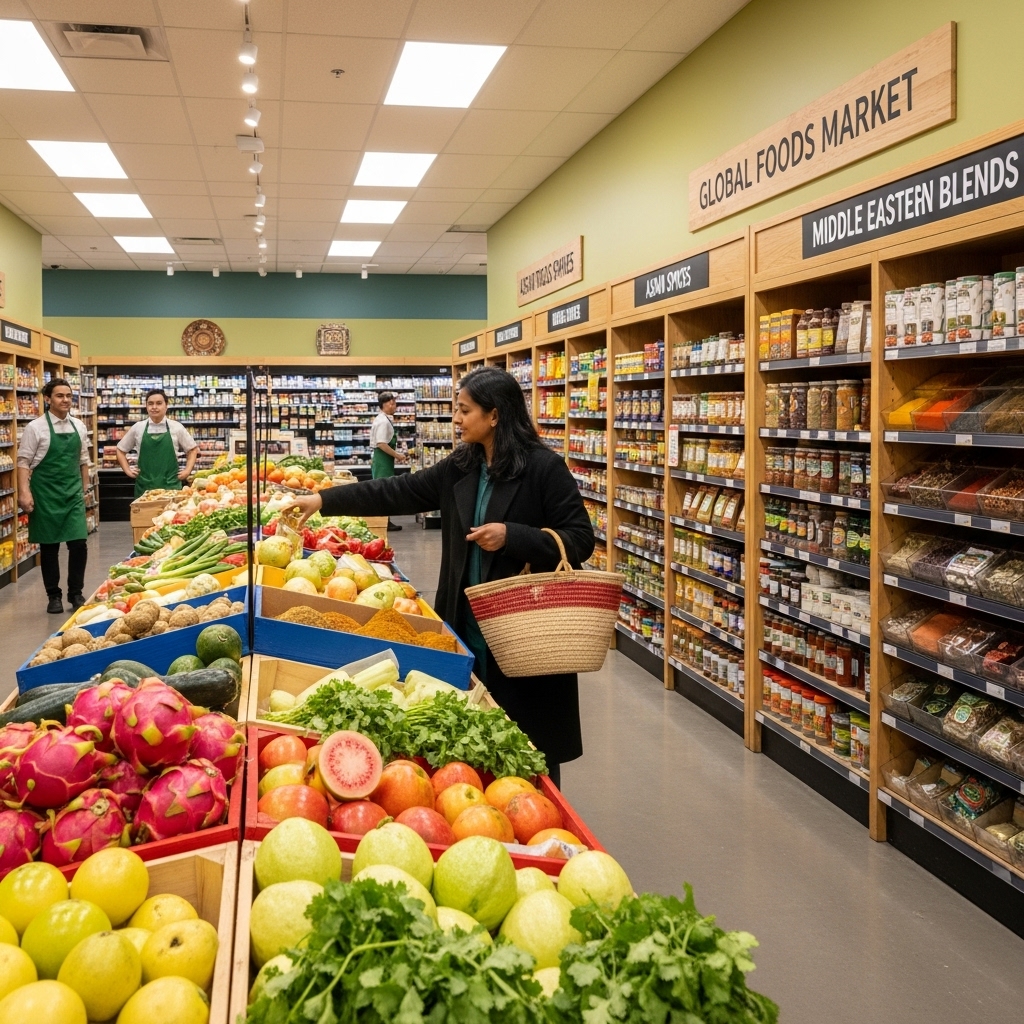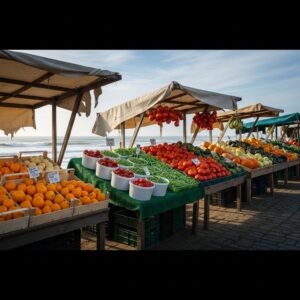Naperville is blessed with a vibrant mix of international groceries, specialty stores, and cultural food hubs that let you taste the world without leaving the neighborhood. Whether you are stocking up for a family celebration, discovering new spices, or just curious about global flavors, this guide will walk you through what to expect, what to buy, and how to shop with confidence. To make the most of seasonal promotions and rotating specialties as you plan your trip, remember to scan local weekly deals early in your planning process so you know what is fresh, featured, and worth building a menu around.
International markets are more than places to purchase groceries; they are community spaces that connect people through food traditions. You will find ingredients that are staples in households across Asia, Latin America, the Mediterranean, Eastern Europe, the Middle East, and Africa. You will also encounter friendly staff who can point you to the right aisle, explain the difference between two similar products, or share a favorite cooking tip.
Understanding the Layout
While every store is different, many international markets follow a familiar layout. Produce often greets you at the entrance with leafy greens, herbs, tropical fruits, and seasonal vegetables. Nearby, you may find bakery counters with breads and pastries from diverse traditions. Deeper inside, aisles stock dry goods, grains, rice, noodles, spices, condiments, and canned goods. Refrigerated and frozen sections wrap around the edges for dairy, tofu, dumplings, specialty cheeses, and ready-to-cook items.
As you walk the aisles, look for signage that groups products by region or cuisine. Some markets create clear sections for Mediterranean, South Asian, East Asian, African, or Latin selections. This helps you shop for a particular recipe or explore an entire culinary region in one concentration.
Produce: Color, Aroma, and Seasonality
Fresh produce is a hallmark of many international markets in Naperville. Expect bundles of herbs such as cilantro, basil varieties, dill, and mint. Look for leafy greens like bok choy, amaranth, or collard-style greens used in stews and stir-fries. Root vegetables may include yucca, taro, daikon, and ginger, while the fruit displays often offer guava, dragon fruit, lychees, and specialty citrus.
Seasonality matters. Ask staff which items just arrived and which are especially fragrant or ripe. Consider planning your weekly menu after seeing what looks best in the produce section. You might switch from a roasted root vegetable plan to a stir-fry if the greens are especially vibrant this week.
Spices, Sauces, and Pantry Staples
The spice aisle is often the heart of any international market. You will find whole seeds like cumin, coriander, and fennel, spice blends for regional dishes, and dried chilies with varied heat and flavor profiles. Sauces and condiments give you shortcuts to authentic tastes: soy sauces with different fermentation styles, tamarind concentrates, chili pastes, pomegranate molasses, harissa, gochujang, and fish sauce, to name a few.
Pantry staples differ by cuisine. Rice varieties range from Basmati and Jasmine to short-grain styles for sushi or risotto-like dishes. Noodles can be wheat-based, rice-based, or made from sweet potato or mung beans. Grains like bulgur, millet, couscous, and teff open the door to new textures and traditions.
Meat, Seafood, and Specialty Counters
Many international markets in Naperville maintain meat and seafood counters that cater to diverse culinary methods. You may find cuts prepared for specific dishes: thin-sliced beef for hot pot, stew cuts for long braises, or marinated options ready for grilling. Seafood counters might carry whole fish, shellfish, and fillets suitable for curries, soups, and oven roasting.
Ask about preparation tips. Butchers and fishmongers often know the best way to cook a certain cut or how to achieve the texture you want. They might even clean or prepare seafood to your specification so it is ready for your recipe.
Frozen and Refrigerated Finds
Do not overlook the freezers. Many international markets stock dumplings, buns, parathas, roti, empanadas, pierogi, and specialty appetizers that can simplify weeknight meals. Refrigerated cases might hold fresh noodles, tofu varieties, yogurt, labneh, kefir, and cheeses used in global cuisines. You can also discover pickled vegetables, kimchi, olives, and cured items that bring brightness and crunch to your table.
Bakery, Sweets, and Snacks
International bakeries are a treat. You might find crusty loaves, flatbreads, stuffed pastries, and sweet confections. Snacks run the gamut from puffed rice mixes and plantain chips to sesame candies and wafer cookies. If you are new to a particular brand or flavor, try a small bag first to discover your favorites.
Reading Labels and Ingredient Tips
Labels at international markets can include multiple languages and scripts. Look for translations or ask an associate for help. Pay attention to spice levels, allergens, and preparation instructions. Some products are concentrated and require dilution, others are fully cooked and only need heating, and some are raw and must be cooked thoroughly.
When experimenting with a new sauce or spice, start with a modest amount and adjust to taste. Keep notes on what you liked and how you might change the balance the next time you cook the dish.
Planning a Visit
Make a simple plan before you go: note the recipes you want to try, make a list of fresh items and pantry refills, and bring reusable bags. If you are curious about a specific cuisine, jot down the core ingredients you will need so you can shop aisle by aisle with purpose. Expect to discover items you did not know you wanted; leave a little space in your plan for an impulse find that inspires a new dish.
Timing your visit can help. Weekdays are often calmer, letting you browse and ask questions. Weekends can be lively, with more fresh deliveries and larger selections. If you are shopping before a holiday, arrive early and plan for popular items to move quickly.
Cooking With Confidence
International markets are wonderful for building new skills. Browse cookbooks or reliable online resources for trustworthy recipes. Watch how ingredients are paired in ready-made items for a shortcut to flavor combinations. If you are making something for the first time, read the full recipe twice, prep your ingredients before you start cooking, and set a reasonable timeline.
Use the market as a teacher. If you see a new vegetable, ask how it is usually cooked—sautéed, steamed, roasted, or simmered. If a spice blend is unfamiliar, ask what dishes it complements. Many stores post cooking notes near certain items, or staff members offer ideas from personal experience.
Middle-of-the-Store Strategies
The middle aisles contain treasure for budget-friendly global cooking. Stock up on rice, beans, lentils, and noodles. Choose a few sauces that can transform leftovers into something new. If you love variety, create a small “international pantry” at home, grouping core items by cuisine so you can pull together a dish without searching. For inspiration on rotating specials that might pair with these staples, keep an eye on local weekly deals and match your pantry to what is especially fresh that week.
Experiment with simple formulas. Stir-fries combine a protein, a vegetable, an aromatic like garlic or ginger, a sauce, and a base like rice or noodles. Mediterranean salads might mix grains, herbs, citrus, olives, and a creamy element like feta or yogurt-based dressings. Stews and curries typically layer aromatics, spices, a liquid base, vegetables, and a protein, simmered until flavors meld.
Entertaining and Sharing
If you are hosting, international markets offer a delightful path to a themed meal. Build a mezze spread with hummus, olives, flatbreads, and grilled vegetables. Create an Asian-inspired noodle bar with different toppings and sauces. Set up a Latin flavors night with salsas, tortillas, marinated meats, and roasted vegetables. Include a dessert table with sweets from several regions so guests can sample around the world.
For potlucks, pick a dish that travels well and reheats nicely. Lentil stews, rice dishes, roasted vegetable platters, and dumplings can be prepared ahead and finished at the event. Label the dish with allergens and spice level if possible so everyone can enjoy with confidence.
Family-Friendly Shopping
Bring kids into the adventure by giving them small assignments. Invite them to choose a new fruit to try, count how many different kinds of noodles they can find, or pick a spice to smell (with permission). At home, let them help wash herbs, shape dumplings, or mix a marinade. Turning shopping into a learning experience builds curiosity and appreciation for global cultures.
Storage, Safety, and Freshness
Once home, store fresh herbs in the refrigerator with stems in water and a loose cover. Keep greens dry and wash them just before cooking. Separate raw proteins from ready-to-eat items, and observe safe handling practices. Freeze portions you will not use soon. Label your containers with names and dates to prevent mystery leftovers.
Building a Weekly Routine
Some shoppers set a weekly routine: one night for a soup or curry, one for a noodle or pasta dish, one for grilling or roasting, and one for a festive platter of small plates. An international market makes this simple. Rotate cuisines to keep meals interesting. Over time, your pantry will fill with versatile ingredients, and your confidence will grow as you revisit favorite recipes.
Support Local and Global Communities
Shopping international markets supports local families, small producers, and import networks that connect Naperville to global foodways. Many stores carry goods from nearby bakeries, farms, and specialty makers alongside imported items. Ask about community events, tastings, and holiday highlights—they often bring neighborhoods together around food and tradition.
Frequently Asked Questions
Q: I am new to international markets. Where should I start?
A: Begin with a simple recipe you want to try and make a list of core ingredients. Start in the produce section for fresh herbs and vegetables, then move to the spice and sauce aisles to collect the flavors that define the dish.
Q: How do I know which brand to choose when I see several for the same item?
A: Ask staff or pick a smaller package to test. Many markets carry multiple brands to suit taste preferences. Keep notes on which ones you enjoy and what you liked about the flavor or texture.
Q: Are there options for special diets?
A: Yes. Many international ingredients naturally support vegetarian, vegan, and gluten-conscious cooking. Always read labels carefully if you have allergies or specific needs.
Q: What if I cannot read the label?
A: Look for translation stickers, shelf tags, or ask an associate for help. You can also search for the product name on your phone using the brand and visual cues to find usage tips.
Q: How should I store spices and sauces?
A: Keep spices in airtight containers away from heat and light. Refrigerate sauces that require it after opening, and mark the date so you know how long they have been in use.
Q: Can I find prepared foods for busy nights?
A: Many international markets offer prepared or ready-to-cook items, from marinated meats to dumplings and flatbreads. They are a great way to enjoy global flavors with minimal prep.
Ready to Explore Naperville’s International Markets?
Set aside time to wander, taste, and learn. Pick one new ingredient each week and build a simple meal around it. When you are ready to plan your next culinary adventure, check local weekly deals to match your menu with what is featured, then bring home a basket of flavors that turns dinnertime into a global tour.




